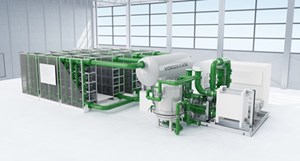Articles
Rapidly scaling up green H2 production
Special Focus: H2 Equipment and Services
J. WAHL, H-TEC SYSTEMS, Houston, Texas
The demand for large-scale hydrogen (H2) projects within the industrial sector is experiencing a rapid rise, as the energy sector, process industries, aviation and marine transport are working hard to reduce greenhouse gas (GHG) emissions. However, not all businesses can reduce their carbon footprint through direct or complete electrification. Where electrification is not possible, fossil feedstock (including natural gas) can be replaced by net-zero fuels.
One of the most promising replacements is the utilization of green H2 and its derivates. The Hydrogen Council estimates that global H2 demand will reach 375 million tons per year (MMtpy) by 2050.1 The global share of green H2 is presently well below 10%, but this will not remain the case. Depending on various scenarios, the global share could reach a third by 2030, and between 75% and 100% by 2050. This means green H2 production must scale up dramatically.
To date, more than 90% of global demand for H2 has been met by H2 from fossil fuels (gray H2), which is used in refineries and in methanol/ammonia production, for example. It is impossible to completely replace gray H2 with climate-friendly green H2. Hundreds of gigawatts (GW) of electrolysis plants will be required to cover even a small proportion of the required H2 production. This has led to a massive demand for electrolyzers to produce green H2.
Against the background of rising renewables with fluctuating loads, proton exchange membrane (PEM) electrolysis technology stands out as a proven and leading technology for green H2 production, particularly for industrial use. The technology offers numerous advantages over other electrolysis processes. Among other things, the production of green H2 using PEM electrolysis can be operated in the dynamic partial load range to compensate for load fluctuations in renewable energies. PEM electrolysis plants are, therefore, ideal for balancing power peaks in the supply grid. This plays an important role in the use of green H2 as a storage and buffer medium for electricity from solar or wind power plants (FIG. 1).
Delivering electrolyzers for large-scale industrial H2 projects. To facilitate a rapid ramping up of H2 production, the author’s company is building a stack manufacturing and development center in Hamburg, Germany, where it will automate PEM stack production. Depending on demand, the plant’s capacity could be scaled up to 5 GW by 2030.
The scalable indoor electrolyzer modular H2 platform (MHP) is a solution specifically designed for the industrial production of green H2. Engineered and designed with a focus on reliability and efficiency, the MHP's highly standardized 10-MW blocks enable easy indoor installation on pre-assembled skids. Each block is equipped with integrated process water treatment and power supply, with provisions for additional water and H2 treatment or oxygen utilization, as needed. The MHP electrolyzer offers a high system efficiency of 77% at 30 bar pressure, surpassing typical values.
An MHP unit with a 10-MW electrical output generates approximately 4,600 kg/d of highly pure H2. Efficiency and availability were key considerations in the strategic design of the MHP. The plant can go from minimal load to nominal load in 30 sec, ensuring that valuable renewable energy is fully utilized.
Redundancy concept for enhanced reliability. System availability is paramount for industrial electrolyzer use and is ensured through a robust redundancy concept. The modular design enhances reliability, with independent controls at the stack cascade level facilitating swift stack replacements and enabling almost full output even in the event of a fault. During maintenance or inspections, a defined portion of the system can be shut down while the rest continues operating. This synergy of high system efficiency, availability and maintenance practices ensures stable operation and minimized H2 production costs.
Modular design for streamlined scale-up. The MHP is modular, skid-mounted and ready-to-install. The scalable modular system allows the combination of 10-MW blocks to multi-MW systems for indoor applications with an electrolysis capacity of 10 MW–100 MW. This allows projects to begin on a smaller scale and expand over time, if needed. The MHP product strategy incorporates proven stacks sourced from the automated stack factory in Germany and integrates a local supply chain in the respective markets. While the MHP is accessible in European regions, the U.S. product variant will be released in 2Q 2024. H2T
About the author

JONAS WAHL is VP Product and Operations USA at H-TEC SYSTEMS. With a university background in engineering and economics, Dr. Wahl has a decade of experience in the power plant and marine industries, where he has been working on the strategy of H2 and Power-to-X. After being responsible for product management at H-TEC for the last 2 yr, Dr. Wahl is now spearheading H-TEC's entry into the U.S. market.
LITERATURE CITED
1 Hydrogen Council, “Global hydrogen flows─2023 update,” 2023, online: https://hydrogencouncil.com/wp-content/uploads/2023/11/Global-Hydrogen-Flows-2023-Update.pdf


